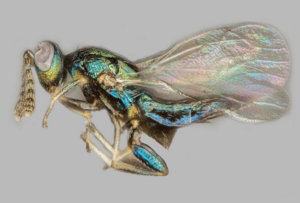Bassettia pallida facts for kids
Quick facts for kids Bassettia pallida |
|
|---|---|
| Scientific classification |
Bassettia pallida is a tiny type of gall wasp. It lives in the Southern United States. An American bug expert named William Harris Ashmead first described this species in 1896.
B. pallida wasps reproduce without a partner (this is called asexual reproduction). They do this inside special bumps called galls. These galls are made by the wasp on oak trees.
Interestingly, another tiny wasp, Euderus set, is a chalcid wasp that acts as a parasite to B. pallida. Euderus set can even change the behavior of B. pallida!
Contents
Discovering the Bassettia pallida Wasp
William Harris Ashmead, an American bug expert, officially described this wasp species in 1896. He based his description on a female wasp specimen. This special specimen, called a holotype, was collected in 1884 in Georgia. It is now kept at the National Museum of Natural History.
Where Bassettia pallida Lives
You can find Bassettia pallida in several states across the southern United States. These states include Georgia, Florida, Missouri, Louisiana, and Texas. The very first specimen used to describe the species was found in Savannah, Georgia.
What Bassettia pallida Looks Like
Adult Female Wasp
An adult female B. pallida wasp is very small, only about 2 mm (0.08 in) long. Its antennae, which are like feelers, have thirteen small parts.
The head, antennae, body (called the thorax), and legs of the wasp are a brownish-yellow color. However, its back legs (the posterior tibiae) and eyes are dark brown. The main part of its body (the abdomen) is a shiny black. There is also a special grooved line around the base of its scutellum, which is a shield-like part on its back.
How Bassettia pallida Lives
Reproduction and Galls
Female B. pallida wasps can reproduce without a male partner. They do this inside galls that form on certain oak trees. These oak species include Quercus geminata, Quercus virginiana, and Quercus minima. All these oaks belong to a group called Virentes.
The galls where the wasps reproduce form on the stems of the oak trees, hidden underneath the bark. Adult B. pallida wasps emerge from these galls in March or April. This timing is perfect because it's when the oak trees start growing new leaves. Scientists believe that sexual reproduction, which involves both male and female wasps, might happen later in galls that form on the middle vein of these new oak leaves.
Parasites and Mind Control
A fascinating chalcid wasp called Euderus set is a parasite of B. pallida. This is a very rare example of "hypermanipulation." This means one parasite (B. pallida) changes its host (the oak tree) to make galls. Then, another parasite (E. set) changes the behavior of the first parasite (B. pallida)!
Here's how it works: B. pallida makes the oak tree form a gall. Then, E. set changes B. pallida's behavior so that the B. pallida wasp chews a hole in the gall. After making the hole, the B. pallida wasp plugs the hole with its own head and dies there. Later, the E. set wasp emerges by chewing a new hole, right through the head of its dead B. pallida host!
Only the B. pallida wasps that reproduce without a partner are targeted by E. set.


